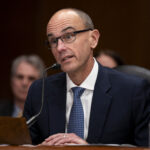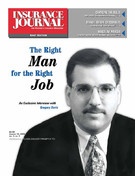An Exclusive Interview with Gregory Serio
Gregory V. Serio, the superintendent of the New York State Insurance Department, is a busy man—moving between Albany, Manhattan, Washington D.C. and elsewhere about the country. So, thanks to Mother Nature, in the form of a blizzard that dropped a foot of snow on New York City, we were lucky to catch up with him in his office, and ask him a few questions.
Serio became the 39th head of what is arguably the most important insurance department in the U.S. in May 2001. He was first deputy for six years before that and the NYSID’s general counsel for three years. He has broad experience as a legislative counsel.
When Gov. George Pataki appointed him, he not only got the right man for the job, but also the right job for the man. Serio’s experience and knowledge run through every facet of New York’s insurance regulatory system, and his influence is felt well beyond his state. His department has become the standard by which others are measured, and in the following interview, he reveals some of the reasons why.
Insurance Journal: What is your view of the current debate over federal versus state regulation of the insurance industry?
Serio: Well, as I said several weeks ago at a conference sponsored by S&P, I think the current debate is largely an ‘inside the beltway’ issue. It may sound surprising, but I think it’s mainly a distraction that keeps us [regulators] away from issues that are really important, and I blame the trade industry associations for telling the Congress they need it, rather than modernizing industry procedures to keep up with change.
IJ: Could you expand on that?
Serio: Two good examples come to mind. Here in New York we’ve developed what we call a ‘speed to market’ process. It’s a set of electronic standards that enables P/C companies to use accepted policy forms for coverage, but only 8 percent or 9 percent of them use it. Why not? Basically because they’re concerned about their senior executives signing forms that say the policy provisions fully comply with state law; plus their lawyers are telling them not to sign.
Then there’s the IIES system through the DMV. In 1997, we began to build it to keep a current record of auto policy coverage, but implementing it has been repeatedly delayed by industry intransigence; they’re reluctant to use it.
So, to get back to your question, if we’ve gone to this much trouble [to introduce more efficiency] where do they get off telling us we’re behind the curve. It’s not just the bigger states either; many of the smaller ones have been following our lead.
IJ: How much leeway does a regulatory department, like yours, actually have to set standards?
Serio: We need to be careful about what we say on standards, as it’s up to the legislature to make the needed changes in the law, but regulators have been pushing the envelope. What our legislative colleagues need to do is to agree on uniform standards; a ‘National Compact’ is the way to go.
It has been discussed by the NCOIL [National Conference of Insurance Legislators], and the burden is on the legislators to create uniform standards—high standards, and that’s part of the problem. I could accept a standard, but the entire process is dogged by the suspicion that the companies are actually only looking for less regulation rather than smarter and more uniform standards. To create one high standard is crucial, but it must be the highest one. Usually the bigger states, New York, Texas, California, Florida, Illinois and Pennsylvania, have the best standards, so ‘take one.’ So far, that hasn’t happened.
IJ: After Sept. 11, New York is perhaps more concerned than anywhere else in the country about terrorism. How serious do you consider future threats, and what needs to be done to meet them?
Serio: The immediate question is what comes after TRIA [the Terrorism Risk Insurance Act] expires. The industry should be working on the next generation of coverage, as it won’t be re-authorized in its present form. They need to work out property insurance rates that will restore stability to the market.
As far as New York is concerned it’s actually less of a problem, as we didn’t authorize changes in the New York Standard Fire policy after Sept. 11, [neither did California] so it still covers a large part of the risk.
IJ: As the superintendent of the department charged with overseeing foreign reinsurer trust funds, how do you feel about recent calls, especially from Lloyd’s, for the provisions to be modified?
Serio: We’ve never said ‘No’ [to lowering the reserve amounts], but it has to be placed in the context of the European and alien insurance communities; you need to make certain there’s adequate financial support. For example, after 9/11 we [the NAIC] reduced Lloyd’s requirements from 100 percent to 60 percent; New York led the way on that, but we opposed making that the new ‘threshold.’ We agreed to give them time to build up their funds.
Right now, the commercial market is in flux and the regulators are looking at it. Do we reduce our standards? Everyone is looking to the U.S. for guidance, but I think lowering the requirements is premature. It should only be done in the context of what is best for U.S. insurers, and by the way, we’re just as hard on them.
IJ: What are your views on some of the other problems the industry faces, such as reserve strengthening, tort reform, asbestos et cetera?
Serio: Firstly, I don’t think you can separate them like that. They really aren’t separate and distinct concerns—terrorism, asbestos, med mal—all of them reflect the general uncertainty over liabilities. Secondly, the problem really relates to capacity; how do we distribute the same pot of money depending on how much is available?
Right now interest rates are in decline. For example the interest on T-bills, which companies are required to hold, is very low, as are all no-equity yields. The industry needs to build up its capital and that means better underwriting, but discipline alone won’t bring it back. We need to take another look at catastrophe reserves and especially at companies’ surplus. They need to put aside some revenue, to create ‘rainy day funds’ to anticipate future needs. In New York, we’ve been doing this since 1996; so after 9/11 we had the money on hand to use it to help people, to give out business grants. That’s a good analogy for the industry.
IJ: Let’s talk about specific New York issues. Your department has vigorously investigated insurance fraud, especially in relation to no-fault automobile coverage and workers’ comp. The State Appeals Court recently validated the NYSID’s reform of Reg 68. What impact do you think this will have on your efforts?
Serio: Reforming Reg 68 is the cornerstone for the creation of a stable auto insurance market in New York. Since we put it in place in April 2002, we’ve seen real improvement in loss development. Forty-five days [to file medical claims after an accident] has seen a real attrition among the scammers. The companies still have 30 days to review the claims, so we’ve held the line on time frames. We’re in a much more stable environment now.
IJ: Could you elaborate on that?
Serio: We’ve gone a long way towards penetrating the fraudsters. We publicize it, because it’s important to let the criminals know we’re on their trail and that they’re looking at jail time for insurance fraud; it’s not just an ‘economic’ crime.
I’ll give you an example. It costs $4000 to insure a car in Brooklyn. Why? It’s a simple case of the costs and the rates; the loss costs are out of sight compared to anywhere else in New York because of the fraud. Compare it to Queens, which is right next door, where they do something about it. [Editor’s Note: the NYSID and state legislators held hearings on the situation in Brooklyn in November, and the NYSID has opened a Fraud Bureau there.]
There are 440,000 drivers in Brooklyn and we can’t get the Senate to pass a ‘felony runners’ bill. They simply don’t seem to understand that these criminals aren’t scared of Riker’s Island. [New York City’s jail for misdemeanor offenses.]
IJ: How are the agents and brokers doing in helping to combat fraud?
Serio: Generally they do a good job. Most of our processing is now fully automated, so we have less problems with assigned risks and ‘straw firm’ brokers. The brokers could maybe do more, as they have all the information, the insurance history of the people they insure. They need to be more vigilant about certain types of people in the system [those with a history of claims exceeding the norms].
IJ: What about med mal rates in New York? Do you see problems on the order of Pennsylvania’s or New Jersey’s?
Serio: No I don’t. We recently raised rates slightly for the first time in seven years. Over that period most rates held steady, even those for neurosurgeons and O.B.’s. We raise rates when they have to be raised, but sometimes the companies give discounts that offset this.
Some 25 years ago, New York reshaped the med mal marketplace by introducing quality mutual reciprocals. They’ve done a good job of maintaining stable rates.
IJ: You mentioned automation earlier. In what way has your department adapted to the “Internet Age?”
Serio: We take great pride in the technical progress New York has made. To begin with, technology is the single most important way to inform the public. For example, our ‘Healthy New York’ campaign used our Web site, TV ads and call centers—a multi media approach—to inform the public about the options available. There’s no way to calculate the benefits we’ve received from the Web site.
Other states have been coming to us for IT ideas.
IJ: The NYSID has a pretty extensive online service for agents and brokers. How does that work?
Serio: We now have fully electronic licensing [through the department’s Web site]. It works at night and on weekends to register license applications and agency terminations; the agents love it, as they can renew any time they want. We’ve torn up the paper.
There was a staff member who went back to the private sector, and filled out all the information on the old forms to renew his agent’s license. When he came in with them, we tore them up, and walked him through the electronic process. This system gives us the ability to renew all types of licenses at the same time, [instead of spreading them out over different years]. Another advantage is the ability to tailor a specific job function to the technology required to perform it. We’re able to save money and improve efficiency.
IJ: You’ve been holding hearings on proposals to expand the New York Property Insurance Underwriting Association’s (NYPIUA) mandate into commercial liability insurance. Do you feel this is necessary, and do you favor it?
Serio: As far as the FAIR Plan is concerned we haven’t made any decisions yet. We’re still getting markedly different opinions from the companies, the agents and the brokers. The commercial property liability market depends a great deal on non-admitted carriers. We want to increase the admitted lines market to provide an alternative.
IJ: Your department has made some changes regarding captive formations. Could you discuss that?
Serio: We’ve loosened the requirements on captives so that New York companies don’t need to go out of state to use them. We recognize that they are a good legitimate business, and they fit in with our goal of giving the public as many options as possible. There’s a shift at hand. Twenty-five percent to 35 percent of business and commercial risk managers see captives as the primary, or ‘first dollar,’ of coverage.
IJ: What has the effect been?
Serio: So far this year we’ve licensed 18 new captives, and we expect to have 20 by the end of the year, but we’re not trying to match Vermont. For one thing, we require a higher level of net worth—at least $100 million—so we’re really aiming at big New York companies.
There’s another effect as well, which we saw with the MTA [Metropolitan Transit Authority] and through studying the reinsurance market. You can build a better loss control program and better insurance product [through the use of captives]. With the MTA captive safety concerns, risk control went way up; They’re now concerned with overall risk management; it’s an entirely new mindset.
IJ: How about the agents? Don’t they lose out when more captives are formed?
Serio: That need not be the case. You’ve got a full range of options, but they may have to change the way they do business in order to remain competitive. They need to concentrate more on loss control and risk management.
IJ: Most major insurers have offices in New York City because it is the financial center of the U.S. Many, such as AIG, have their headquarters there. Does this create any special problems for a regulator?
Serio: It actually helps to have a broad-based constituency. We can approach companies with a sense of being able to balance our needs and theirs. It also helps to team up with the best agents and brokers, especially when we are fully engaged in discussions in Washington, D.C.
IJ: What about the agents and brokers? Do you have any problems with them?
Serio: We’ve got a good agent and broker market, and there aren’t really any serious market conduct problems. They’re the cornerstone of the insurance market, with a significant presence; that shouldn’t be changed.
IJ: Has the NYSID gotten involved in the insurance disputes involving recoveries from the destruction of the World Trade Center?
Serio: We’re watching and monitoring the situation; that’s all. No, I’m not going to express an opinion on the WTC coverage issue [the ‘one occurrence/two occurrences’ dispute between Silverstein Properties and Swiss Re], except to say that $3.5 billion is a lot of money, and maybe they galvanized their respective positions too early on. What they need now is some creative input.
IJ: Where do you think that might come from?
Serio: Gov. Pataki is the only person in a position to do anything. At the end of the day, nothing’s possible without his input. The main concern is the delay, but the governor effectively got Deutsche Bank and Allianz together [the two have agreed concerning an office building damaged in the WTC attacks].
Gov. Pataki’s role in establishing the time frames is crucial, and I know he’s working hard to come up with solutions.
IJ: One last question. Where do you plan to go next? Any idea of running for public office?
Serio: Definitely not. My wife wouldn’t let me. Actually, I’m rather attracted by the business side of the industry; I find it appealing. But I’m not leaving anytime soon. I feel that working with the governor we’ve been able to establish consistency within the agency; we’ve given it organization and method.
Topics USA Agencies Legislation Fraud New York Talent Market
Was this article valuable?
Here are more articles you may enjoy.


 Insurance Industry ‘Megadeals’ Dominate 2025, Says PwC
Insurance Industry ‘Megadeals’ Dominate 2025, Says PwC  Man Sentenced for Flashing Three Insurance Agencies in Georgia
Man Sentenced for Flashing Three Insurance Agencies in Georgia  Fifth La Niña in Six Years to Disrupt Crops and Supply Chains
Fifth La Niña in Six Years to Disrupt Crops and Supply Chains  McKinsey Plots Thousands of Job Cuts in Slowdown for Consulting Industry
McKinsey Plots Thousands of Job Cuts in Slowdown for Consulting Industry 


